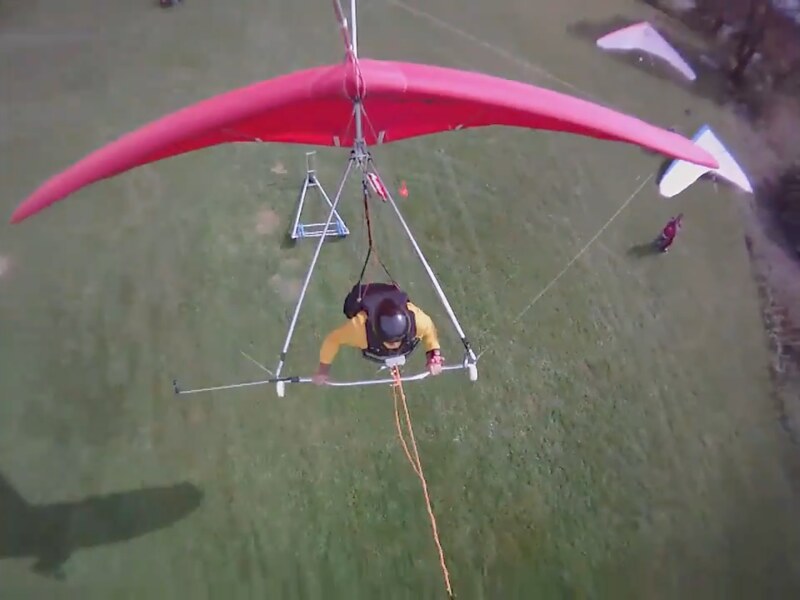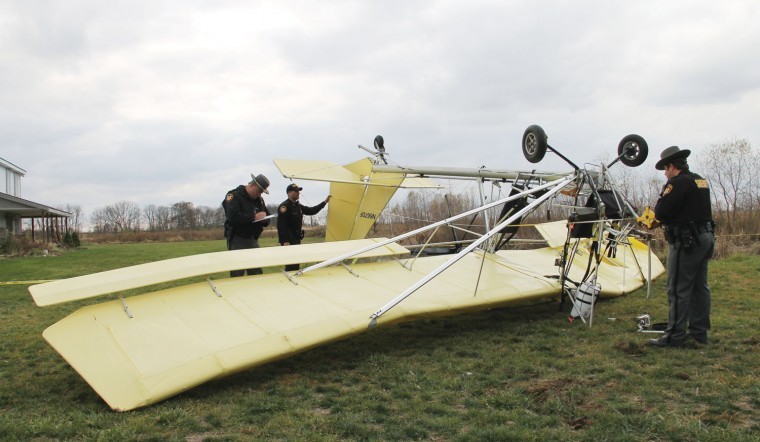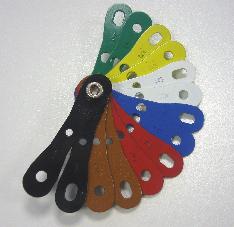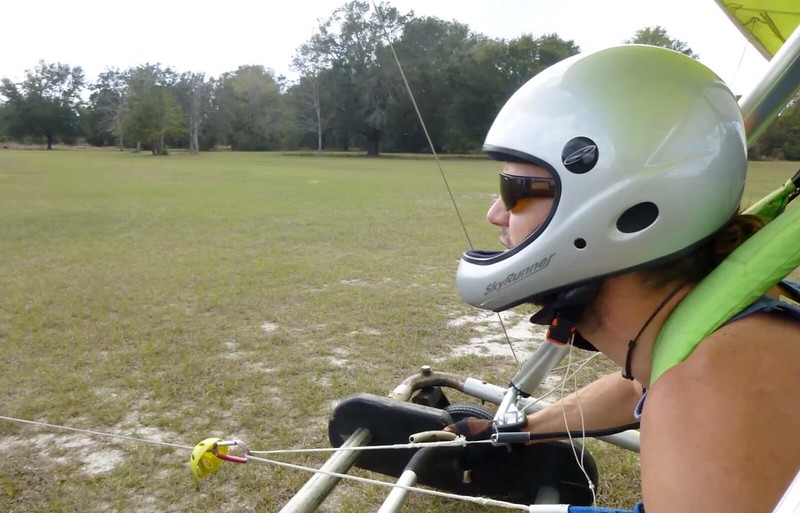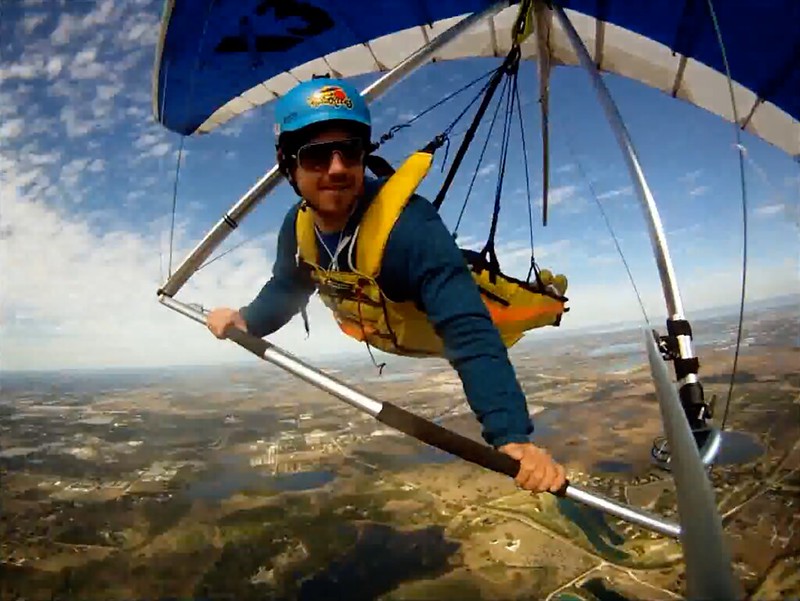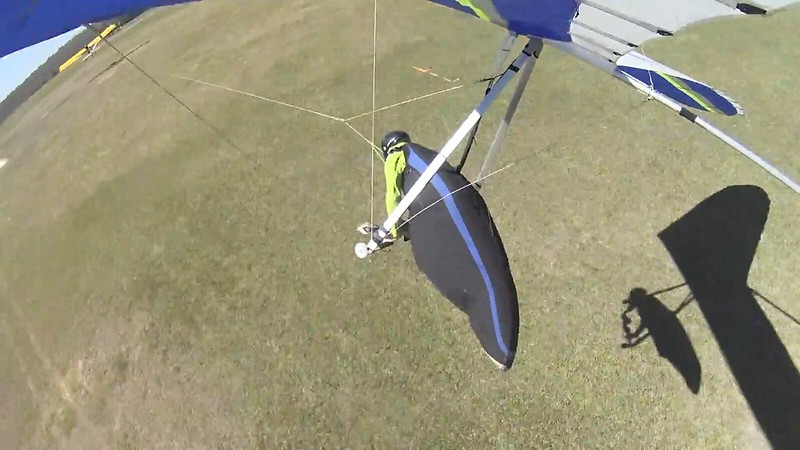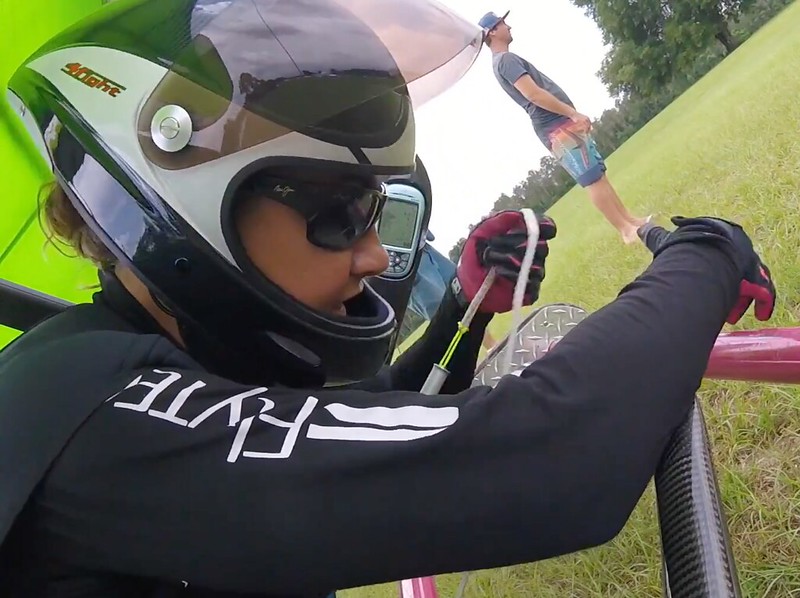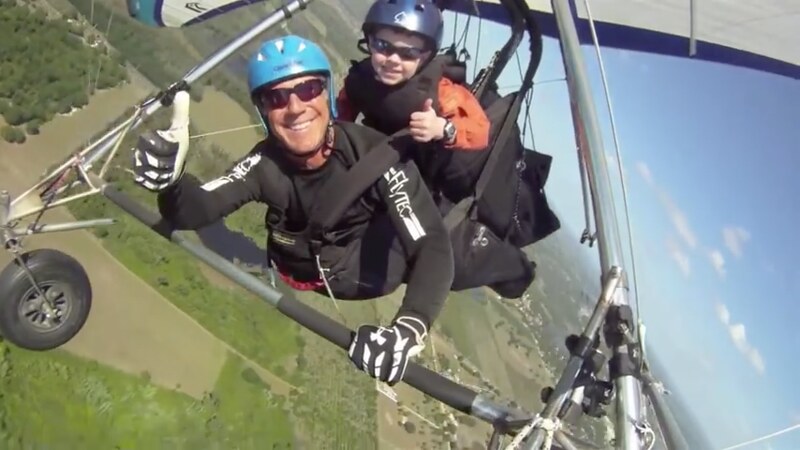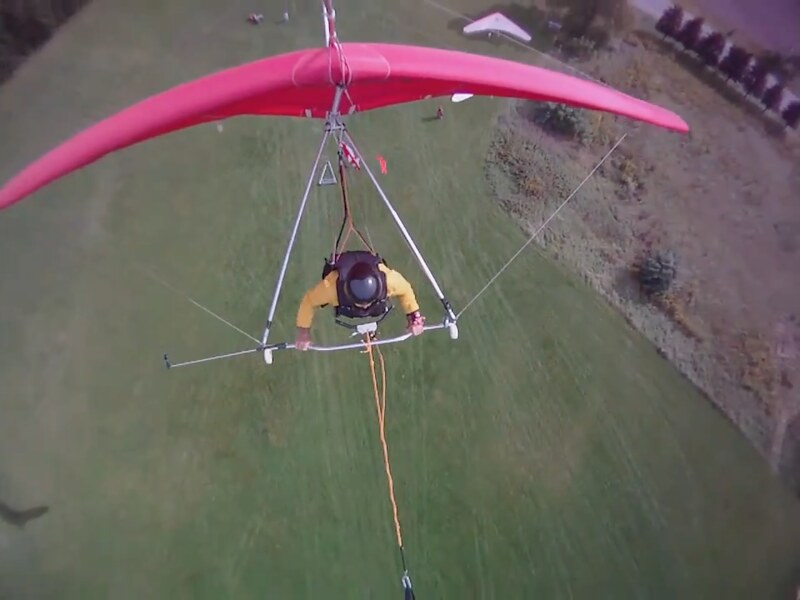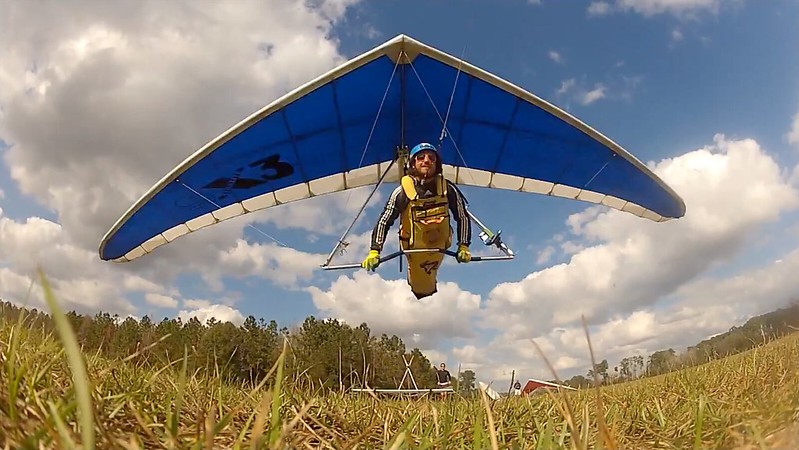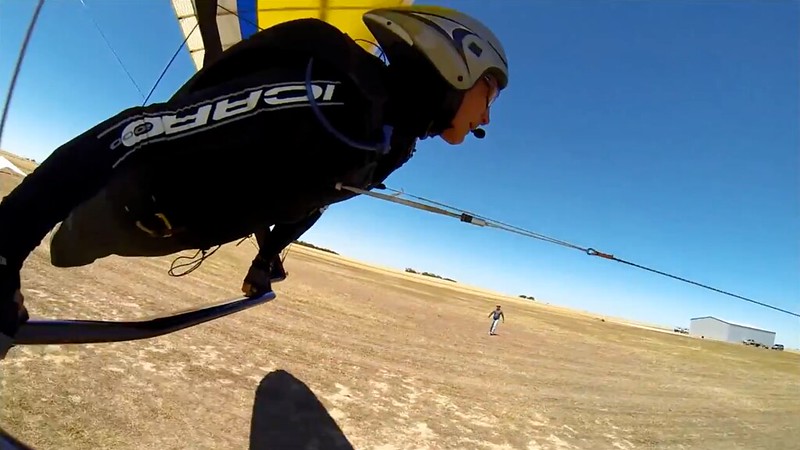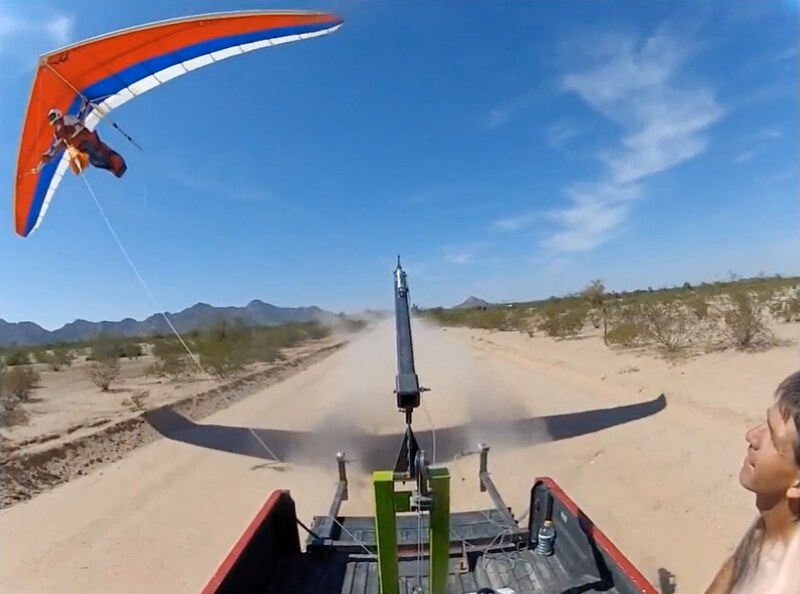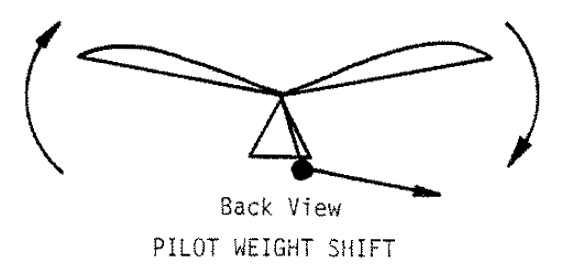http://groups.yahoo.com/group/skysailingtowing/message/4633
Weaklinks and aerotowing (ONLY)
Steve Kroop - 2005/02/10 04:50:59 UTC
To: Davis Straub; Tow Group
Cc: Rohan Holtkamp; Paris Williams
Davis,
Your weak link comments are dead on. I have been reading the weak link discussion in the OR with quiet amusement. Quiet, because weak links seem to be one of those hot button issues that brings out the argumentative nature of HG pilots and also invokes the "not designed here" mentality and I really did not want to get drawn into a debate. Amusement, because I find it odd that there was so much ink devoted to reinventing the wheel. Collectively I would say that there have been well over a 100,000 tows in the various US flight parks using the same strength weak link with tens of thousands of these tows being in competition. Yes I know some of these have been with strong links but only the best of the best aerotow pilots are doing this.
You are completely correct about weak links and lockouts. If I can beat the horse a little more: Weak links are there to protect the equipment not the glider pilot. Anyone who believes otherwise is setting them selves up for disaster. The pilot activating his or her releases is their way to save themselves. A perfect analogy is the circuit breaker in your home, it is there to protect the wire not what you plug into the wall socket. If anyone does not believe me they can plug their car retrieve 2-way radio into the wall socket and watch it go up in flames with the circuit breaker cumfortably remaining in the on position (I hope no one really tries this

.
A discussion of the strength of weak links is incomplete without a discussion of the tow bridal. I hear (read) strengths quoted with respect to the combined pilot and glider weight yet this is meaningless info with out knowing what bridal configuration is used and where it is placed in the bridal system. For example, a 200# weak link can allow between 200# and 800# of towline force depending on where it is placed within the various popular bridal configurations.
On the tow plane we use 1-1/2 loops (3 strands) of 130# line. The weak link is placed in the top of a V-bridal which would yield a maximum nominal towline tension of around 780#. However, due to the fact the knots (two are required since there are three strands) are not "buried" the maximum towline tension is greatly reduced. I do not know the exact tow line tension required to break this weak link but the value is somewhat moot since the weak link is not too strong so as to cause any damage to the tow plane and it is not too weak to leave the glider pilot with the towline.
Summary
Do not attempt to aerotow unless you have received proper training
Do not attend an aerotow comp if you do not have considerable experience flying a comp class glider in comp class conditions
Weak links are there to protect the equipment
Weak links do NOT prevent lockouts and no amount of weak link rules will prevent lock outs
In the event of a lock out releases are there to save the pilot
Best regards, Steve - Flytec USA
#1 instruments in the world for Hang Gliding, Paragliding and Ballooning
800-662-2449 (inside the US)
+352-429-8600 (outside the US)
+352-429-8611 (fax)
http://www.flytec.com
Your weak link comments are dead on.
What are they nowadays, Steve? Not long after the 2013/02/02 fatal inconvenience stall and tumble at Quest Davis and many of us suddenly became happy with a slightly stronger weak link and he stopped telling us what an appropriate weak link would be under the rules of his pecker measuring contests. So if his comments were dead-on eight years prior (right after Robin Strid's Tad-O-Link failed to succeed when it was supposed to - "before the pressure of the towline could reach a level that would compromise the handling of the glider" (in the immortal words of your base of operations) - and killed him and critically endangered Bobby Fucking-Genius Bailey...
http://ozreport.com/9.008
2005 Worlds
Davis Straub - 2005/01/10
As he took off his left wing was dragging. Bobby Bailey, the best tow pilot in the business, moved to the right into get further into the wind, and Rob got his left wing up and flying as he lined up behind Bobby.
...the best tow pilot in the business) they're obviously slightly off of dead-on now.
I have been reading the weak link discussion in the OR with quiet amusement.
So how come you're just sending this to Davis to post on The Peter Show (and ccing to Rohan Holtkamp and Paris Williams) and not posting this on the weak link discussion in the OR with quiet amusement? 'Cause the OR is publicly viewable and Peter's sleazy little dump isn't?
Quiet, because weak links seem to be one of those hot button issues that brings out the argumentative nature of HG pilots...
- UPPITY HG pilots.
- Oh. The argumentative nature of HG pilots... Let's work hard and find some aspect of hang gliding that isn't a total load o' shit.
- How 'bout foot launching on a shallow slope in iffy air? Does anybody ARGUE that you SHOULDN'T hold your pitch down to a low angle of attack, run like hell, power the glider to the maximum extent physically possible, ease up on the pitch until your feet leave the ground?
- Or:
http://ozreport.com/forum/viewtopic.php?t=9230
Departing the launch cart
Jim Rooney - 2007/09/01 02:39:53 UTC
Which brings us to the reason to have a 914 in the first place... you need one.
Something made you get a 914 instead of a 582. 914s are horribly expensive to own and maintain. If you own one, you need it... it's a safety thing. Short runways, tall trees, whatever. You've got a 914 to increase your safety margin.
Show me an argument contrary to that one. Which is actually identical to the previous one. Anybody standing in line to trade his 914 in for a 582 so's he can floor it and still be using and delivering safer lower thrust?
- Another example...
http://ozreport.com/forum/viewtopic.php?t=31052
Poll on weaklinks
Jim Rooney - 2013/03/04 19:31:36 UTC
The accepted standards and practices changed.
Morningside decided that they were happy with 200lb weaklink.
Quote me one single motherfucker breathing a single word to the effect that Jeff Bohl - one of the best of the best of the best (got an annual XC event named in his memory ferchrisake (speaking again of Cowboy Up)) - might have walked away smelling like a rose if only he hadn't been using a Tad-O-Link to protect his equipment.
Somebody name me a topic that's LESS likely to bring out the argumentative nature of HG pilots these days. That Ponzi scheme isn't even dust lightly drifting away from the rubble of the collapse anymore. And all the motherfuckers who propped it up and aided and abetted for all those decades treat it like plutonium now 'cause they all know they can and will be quoted.
So maybe you just get arguments when the mainstreamers are totally full o' shit - which is damn near everything in this total shit-hole of a flavor of aviation.
- You're a hang glider pilot, right? How come YOU don't have enough of an argumentative nature to engage in any public discussions and help get this critical issue properly sorted out?
...and also invokes the "not designed here" mentality...
Right Steve. A one-size-fits-all loop of 130 pound test fishing line hooked onto one end of a pro toad bridle was something that was DESIGNED somewhere. That's the upper limit of the engineering capacity of you Flight Park Mafia dickheads. And...




...you're not even capable of getting that much right.
...and I really did not want to get drawn into a debate.
- HG pilots don't seem to have such an argumentative nature nowadays. Did you see how long this one:
http://www.hanggliding.org/viewtopic.php?t=36170
Weak Links?
lasted?
- I can certainly understand why a semiliterate Industry douchebag such as yourself wouldn't wanna get drawn into any debates with any of us clueless muppets. Best continue confining yourself to closed-to-the-public inbred little dumps like The Peter Show in which the opposition will be silenced whenever things start getting out of hand.
- Fuck anybody who actually knows what the hell he's talking about on critical black and white safety issues and doesn't wanna get drawn into debates. That's another way of saying Flight Park Mafia students and victims are getting crashed and killed due to general cultural incompetence and you don't really give a rat's ass.
Amusement, because I find it odd that there was so much ink devoted to reinventing the wheel.
Must've finally run outta ink. 'Cause for some years now you can't find shit about what shape wheel people are currently using and what it's supposed to be doing for them.
Lemme tell ya EXACTLY how your wheel was invented, motherfucker. It had absolutely NOTHING to do with protecting any equipment and was TOTALLY for the purpose of preventing the glider from being able to climb out at a high enough pitch attitude to permit a stall WHEN the one G focal point of its safe towing system succeeded. You'd need to multiply that tow force by about seven before you'd need to start to worry about a threat to the "EQUIPMENT". That wheel was the most indescribably moronic innovation ever to find its way into any flavor of aviation. And it needed the fertile soil of hang glider cultural incompetence and stupidity to take root and thrive.
Collectively I would say that there have been well over a 100,000 tows in the various US flight parks using the same strength weak link with tens of thousands of these tows being in competition.
- Wow! That's a really long track record! People doing the same thing over and over again continually expecting optimal results - the fishing line preventing one from getting into too much trouble. Really hard to beat it.
- The same strength weak link? A few months back the FAA expanded its AT weak link regs to cover hang gliders. They specify weak links in proportion to the glider's max certified operating weight. But we're still doing one-size-fits-all Davis Links without protesting this clueless regulatory intrusion? How come?
- Since then two professional pilots have been killed launching at Quest - one whose Standard Aerotow Weak Link increased the safety of the towing operation and another whose Tad-O-Link failed to succeed when it was supposed to. Any comment on either? Didn't think so.
Yes I know some of these have been with strong links...
A strong link? What's that? I'm guessing...
http://ozreport.com/3.066
Weaklinks
Davis Straub - 1999/06/06
During the US Nationals I wrote a bit about weaklinks and the gag weaklinks that someone tied at Quest Air. A few days after I wrote about them, Bobby Bailey, designer and builder of the Bailey-Moyes Dragon Fly tug, approached me visibly upset about what I and James Freeman had written about weaklinks. He was especially upset that I had written that I had doubled my weaklink after three weaklinks in a row had broken on me.
http://ozreport.com/9.032
The Worlds - weaklinks
Davis Straub - 2005/02/07
For a couple of years I have flown with a doubled weaklink because, flying with a rigid wing glider, I have found that there is little reason to expect trouble on tow, except from a weaklink break.
http://ozreport.com/forum/viewtopic.php?t=24846
Is this a joke ?
Davis Straub - 2011/08/26 14:04:52 UTC
We had six weaklink breaks in a row at Zapata this year. Russell Brown (tug pilot, tug owner, Quest Air owner) said go ahead and double up (four strands of Cortland Greenspot). He knows I used his Zapata weaklink in Big Spring (pilots were asked to tell the tug pilot if they were doing that).
...a doubled loop of 130. 'Specially since you're talking to Davis and he's so very obviously one of the best of the best and his comments are always so dead on.
So how come you're so studiously not saying anything about strong link strengths or tandem gliders - motherfucker?
...but only the best of the best aerotow pilots are doing this.
- What about tandem rides? Aren't they using exactly what the best of the best solo guys are? You know goddam well they are.
http://www.questairforce.com/aero.html
Aerotow FAQ
Weak Link
Most flight parks use 130 lb. braided Dacron line, so that one loop (which is the equivalent to two strands) is about 260 lb. strong - about the average wing load of a single pilot on a typical glider. For tandems, either two loops (four strands) of the same line or one loop of a stronger line is usually used to compensate for nearly twice the wing loading.

That was up from the beginning of time until around late last decade when you assholes started figuring out that this clueless bullshit was a major liability to you.
- Really? I thought you said:
Weak links are there to protect the equipment
Weak links do NOT prevent lockouts and no amount of weak link rules will prevent lock outs
So do the best of the best pilots need less equipment protection? They're willing to accept more equipment damage? And what's the tradeoff? They're using heavier and draggier weak links so their climbs are gonna be slower and they'll be carrying extra weight for the durations of their free flights. I'm not understanding what the logic is here.
Are the best of the best pilots also using smaller parachutes and lighter helmets with less shock absorption capacity? If not then there's something seriously wrong with this picture.
Ya know who needs less equipment protection? The larger gliders. 'Cause smaller gliders - being constructed from the same strength/diameter tubing, wires, hardware but of lesser square footage and carrying lighter pilots - are proportionally stronger than larger gliders of the same models. So is anyone actually implementing that flavor of scaling?
- So you're obviously doing the third person plural thing with respect to the best of the best. Meaning you're just another Standard Aerotow Weak Linking muppet. So how come we're not hearing from any of the rockstars who fly the strong links? How come they're not posting videos illustrating the techniques they've learned to be able to safely fly the Tad-O-Links, running Tad-O-Link seminars to bring us muppets up to speed, getting a Tad-O-Link Special Skill signoff established for the Pilot Proficiency Program so's a Tad-O-Linker from Quest can show up at Whitewater and be good to go without having to waste valuable time convincing his tug driver of his rockstar status?
- Only the best of the best aerotow pilots are doing this...
http://www.chgpa.org/forums/viewtopic.php?f=2&t=2467
weak links
Jim Rooney - 2007/07/22 22:30:28 UTC
I've heard it a million times before from comp pilots insisting on towing with even doubled up weaklinks (some want no weaklink). I tell them the same thing I'm telling you... suck it up. You're not the only one on the line. I didn't ask to be a test pilot. I can live with your inconvenience.
Sounds to me like a million comp pilots consider themselves to be the best of the best. And nobody's arguing - despite the argumentative nature of HG pilots - otherwise. Pro toad bridles, state of the art bladewings with sprogs set as low as they can get away with, wheel-less basetubes, racing harnesses which...
http://ozreport.com/13.238
Adam Parer on his tuck and tumble
Adam Parer - 2009/11/25
Due to the rough conditions weak links were breaking just about every other tow and the two tugs worked hard to eventually get everyone off the ground successfully.
...jam parachute deployment after tumbles... So how come they're not being permitted to fly with equipment commensurate with their masterful skill levels?
Safety of the tug driver? The best of the best comp pilots can't control their solo wings as well as the crappiest tandem thrill ride driver on the planet using the exact same strong link?
You are completely correct about weak links and lockouts.
Which is really amazing - seeing as how for a decade or so the motherfucker was dictating the one-size-fits-all Standard Aerotow Weak Link for all competitors, regardless of glider, flying weight, bridle configuration, skill level with no clue as to its actual breaking strength.
So how 'bout here?:
http://ozreport.com/forum/viewtopic.php?t=31052
Poll on weaklinks
Davis Straub - 2013/03/06 18:29:05 UTC
You know, after all this discussion I'm now convinced that it is a very good idea to treat the weaklink as a release, that that is exactly what we do when we have a weaklink on one side of a pro tow bridle. That that is exactly what has happened to me in a number of situations and that the whole business about a weaklink only for the glider not breaking isn't really the case nor a good idea for hang gliding.
I'm happy to have a relatively weak weaklink, and have never had a serious problem with the Greenspot 130, just an inconvenience now and then.
Doesn't sound like he's so completely right about weak links after racking up another eight years worth of comp flying and risk mitigation plan writing. Sounds more like he's constantly trying to figure out which way the cultural wind will be blowing and position himself accordingly.
If I can beat the horse a little more:
Oh ferchrisake, Steve. This horse has been BEATEN TO DEATH ten times over. We know what we're doing and have a track record of collectively, I'd say, well over a hundred thousand tows in the various US flight parks using the same strength weak link - with tens of thousands of those having been in competition. Yes, I know some of these have been with strong links but only the best of the best aerotow pilots are doing this.
And just watch what happens when you put some low time Three muppet up on a strong link - if you're having trouble understanding why. Right off the cart he starts oscillating all over the place and refuses to release because he thinks he can fix a bad thing and doesn't wanna start over. And the tug driver doesn't fix whatever's going on back there by giving him the rope 'cause he's too busy trying to keep his plane from piling in to make the easy reach to his release. And the tug weak link won't function with a stronger one on the back end. The results are never pretty.
Weak links are there to protect the equipment not the glider pilot.
- Don't you mean the EQUIPMENT pilot? That's the only thing we hear about that's being protected by the weak link in this post. "Glider" pilot is far too restrictive a term because the weak link is also protecting the backup loop, harness, parachute, release, instrument deck, radio, hook knife... Anything solid that goes up behind the tug that doesn't have a pulse.
Asterisk. Well, 'cept for a tandem student. They never touch the control bar and serve only as ballast and thus full under the category of equipment - which the weak link, under the clearly stated terms of the contract, is required to protect.
- Well good. 'Cause if they were there to protect the glider pilot then the best of the best glider pilots would be less well protected than the crappy muppet jobs like T** at K*** S******. That would be totally insane - the polar opposite of natural selection / the Darwinian evolutionary progression.
- Bullshit. The goddam pilot's a component of the glider - 'specially a hang glider. He's the EQUIPMENT that keeps it under control and he's about a thousand times more expensive than the rest of the equipment put together. If he breaks his fuckin' arm that's multiple times the expense of all the other equipment put together. It's virtually impossible to protect one without protecting the other and statements like:
Weak links are there to protect the equipment not the glider pilot.
are pure unadulterated bullshit and the people who make them are filled to the brim with same. There's nothing that's a component of a properly designed sport aircraft or towing system - wings, wires, wheels, skids, helmets, parachutes, tugs, towlines, bridles, releases, weak links, instruments - that isn't there for the protection and safety of planes and pilots. Name anything and I can give you a scenario in which it will:
-- save your ass and/or glider
-- be of zero relevance
-- kill your ass and/or glider
Wheels have kept a lot of necks from being broken; will be of zero use in keeping your brain from being mushed if you select a wheat field as your landing option; can, if they're not lockable, be real problematic if you get caught by a wind surge alone on a launch ramp. (Ask Steve Kinsley about that last one.)
Weak links, 'specially the Infallible kind, have defused low level lockouts and prevented overload situations, ALWAYS on gliders equipped with Reliable Releases; been causes of inconvenience at launch (not to mention forever lost prime flying days); stalled and killed gliders fighting for control at up to a couple hundred feet.
Anyone who believes otherwise is setting them selves up for disaster.
- Semiliterate u$hPa / Flight Park Mafia operative total douchebag.
- OH! So then everybody not using a Tad-O-Link, the south-of-the-best-of-the-best muppet 99.8 percent who are using these Standard Aerotow Weak Links that will blow six times in a row in light morning conditions, are setting themselves up for disaster!
- So how many of these disasters manifest themselves in the course of an average flying season and what responses do we typically get from u$hPa, the Flight Park Mafia, the FAA?
- How 'bout the total fucking douchebags like your dear friend, Jim Keen-Intellect Rooney?
http://ozreport.com/forum/viewtopic.php?t=24846
Is this a joke ?
Jim Rooney - 2011/08/26 02:44:10 UTC
Zach, you can nit pick all you like, but I'll put a 100,000+ flight record over your complaints any day of the week.
Let me see if I can clear up a few things for ya.
A lot of this I sent to Steve btw...
The "purpose" of a weaklink is not in question. Your semantics are.
The "purpose" of a weaklink is to increase the safety of the towing operation. PERIOD.
There are many ways in which it accomplishes this.
You're nit picking over what you call the "true purpose"... but all you're griping about is a definition... and an erroneous one at that.
Again, The weak link increases the safety of the tow.
Now, how it does this also provides a telling answer to one of the most hot button topics surrounding weak links... lockouts.
People will rail up and down that weaklinks do not protect against lockouts... which they don't.
But this is a half truth.
The whole truth is that while they don't prevent them, they help.
Aren't they ALSO setting the equipment pilots up for disaster? Maybe you can provide us with a list of u$hPa certified AT instructors, flight park operators, tug pilots who AREN'T setting the equipment pilots up for disaster.
The pilot activating his or her releases is their way to save themselves.
- And only the best of the best understand this concept. It's the muppets who always think they can fix bad things and don't wanna start over. That's why they need better equipment protection. But they still don't understand that while the equipment will come through totally unscathed they themselves will be lucky to come off with long hospital stays. This is due to the differences in the protection capabilities of the relevant safety devices.
- What if its a reliable easy reachable release with no load capacity? Doesn't the pilot cease being a pilot the millisecond he takes his hand off the control bar? Is it possible for a situation to exist in which the pilot will die if he:
-- remains on tow
-- stops flying the glider to separate themselves from tow
Heads I win, tails you lose?
Which option would you recommend in such a situation? What are the best of the best...
http://c2.staticflickr.com/8/7077/27082298482_cda1aba01b_o.png
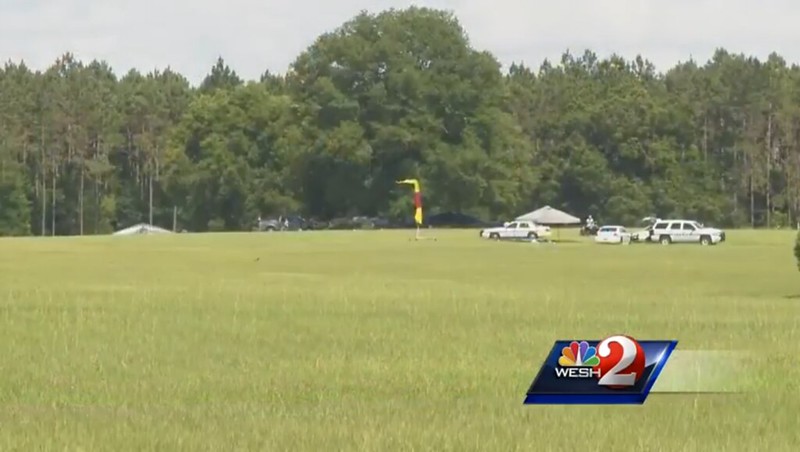
...usually doing in these situations?
- Won't the tug pilot...
http://www.chgpa.org/forums/viewtopic.php?f=2&t=2467
weak links
Jim Rooney - 2007/08/01 13:47:23 UTC
Whatever's going on back there, I can fix it by giving you the rope.
...fix whatever's going on back there by giving us the rope? Hasn't he already done it by this point? Or...
09-20
http://c2.staticflickr.com/6/5315/29962431842_1b260f7a81_o.png
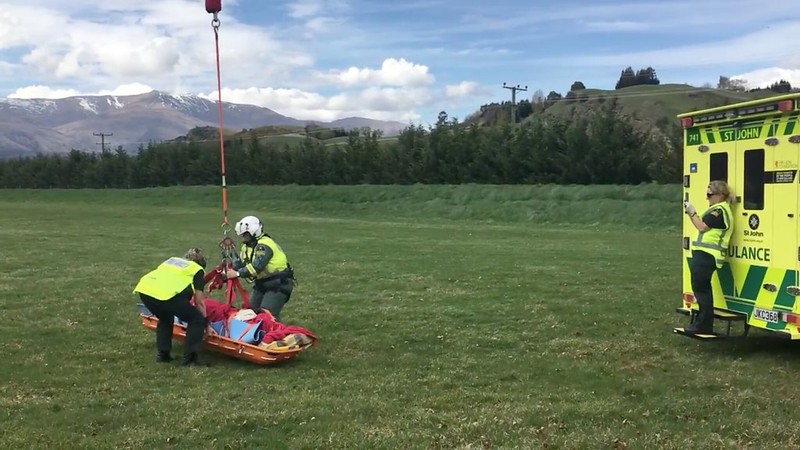
...maybe we shouldn't be putting as much faith in him as he's assuring us we can. Any thoughts? (Funny you're not mentioning anything along this line.)
A perfect analogy is the circuit breaker in your home, it is there to protect the wire not what you plug into the wall socket. If anyone does not believe me they can plug their car retrieve 2-way radio into the wall socket and watch it go up in flames with the circuit breaker cumfortably remaining in the on position...
Wow! I never thought of it that way before, Steve! That's a really useful perfect analogy! Really clears things up for me on this weak link issue. So I guess only the best of the best can plug their car retrieve 2-way radios into the wall sockets and NOT watch them go up in flames with the circuit breakers cumfortably remaining in the on position.
(I hope no one really tries this

.
'Cept for the best of the best, of course. I so do admire they way they remain so cumfortable while using safety devices which would kill us mere mortals in a nanosecond.
A discussion of the strength of weak links is incomplete without a discussion of the tow bridal. I hear (read)...
I'm assuming that your reading level sucks as much as your writing level.
...strengths quoted with respect to the combined pilot and glider weight yet this is meaningless info with out knowing what bridal configuration is used and where it is placed in the bridal system.
Oh good. Some Flight Park Mafia asshole who thinks that "without" is two words and can't even spell "bridle" is gonna tell us muppets all about the various bridle / weak link configurations.
For example, a 200# weak link can allow between 200# and 800# of towline force depending on where it is placed within the various popular bridal configurations.
- Also... If you use weak links on BOTH ends of a bridAl at Quest or Florida Ridge it doubles the tension required to blow off tow.
- Various popular bridal configurations...
-- Can you tell us which ones tend to be the most popular and why?
-- I guess they all trim the glider equally well...
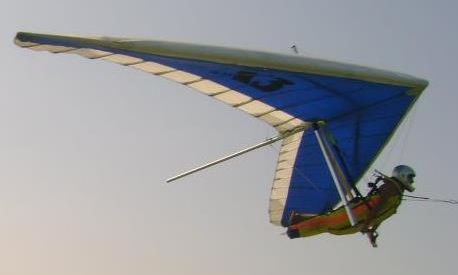 http://www.hanggliding.org/viewtopic.php?t=22233
http://www.hanggliding.org/viewtopic.php?t=22233
Looking for pro-tow release
Davis Straub - 2011/06/16 05:11:44 UTC
Incorrect understanding.
Otherwise you'd certainly be bringing this issue up in order to complete the discussion.
- No it can't. The only way it can limit the towline tension to 200 is if it's on the end of the towline in front of one of the various popular bridal configurations. And nobody configures that way anyway.
- Ignoring the issue of increase in weak link loading with increase in two point bridle apex angle - which all you assholes do anyway - you could only get 800 by installing the 200 on an end of the secondary bridle. Which nobody, even in hang gliding, has ever been stupid enough to do.
- At Quest and Florida Ridge flying two point with two hundreds installed on both ends of the secondary and the top end of the primary you could get up to 1800. Hell, let's stick another one on between the end of the towline and the tow ring and bring it up to an even two thousand. And this would override the crap outta what's on the tug and either prevent the equipment from getting airborne at all or kill it instantly. Nobody's really sure which.
- Note that:
-- none of the various popular bridal configurations this asshole's talking about include a secondary weak link anywhere so the only reliable weak link they have is the towline.
-- while untold thousands of tug drivers have refused to pull solos with anything over a 130 on a back end bridle end due to the insane risk that would pose to the tug not one of them has ever required configurations in which reliable weak link protection...
http://www.hanggliding.org/viewtopic.php?t=14230
pro tow set-up
Jim Rooney - 2009/11/02 18:58:13 UTC
Oh it happens.
I have, all the guys I work with have.
(Our average is 1 in 1,000 tows)
Oh yeah... an other fun fact for ya... ya know when it's far more likely to happen? During a lockout. When we're doing lockout training, the odds go from 1 in 1,000 to over 50/50.
...actually exists...
Towing Aloft - 1998/01
I witnessed a tug pilot descend low over trees. His towline hit the trees and caught. His weak link broke but the bridle whipped around the towline and held it fast. The pilot was saved by the fact that the towline broke!
...anywhere.
On the tow plane we use 1-1/2 loops (3 strands) of 130# line.
Yeah? I thought you were using...
http://ozreport.com/5.126
Flytec Dragonfly
USAFlytec - 2001/07/14
Steve Kroop - Russell Brown - Bob Lane - Jim Prahl - Campbell Bowen
The tail section of the Dragonfly is designed so that it can accept in-line as well as lateral loads. Furthermore the mast extension, which is part of the tow system, is designed to break away in the event of excessive in-line or lateral loads. The force required to cause a breakaway is roughly equivalent to the force required to break the double weaklink used on the tail bridle. More simply put, the mast would break away long before any structural damage to the aircraft would occur.
...a double loop (4 strands) of 130# line. What happened? Did you fuckin' dickheads finally figure out that if you make the tow mast and tug end and best of the best solo glider weak links all the same strength then a third of the times the:
- tug will fly away with the towline and a severely stressed tow mast
- glider will fly away with the towline and the tug will fly away:
-- with a severely stressed tow mast
-- minus its tow mast
So now you've fixed the problem such that:
- your breakaway tow mast is better protected
- a muppet leaves you with the towline
- the best of the best and your tandem rides fly away with the towline
The weak link is placed in the top of a V-bridal which would yield a maximum nominal towline tension...
- Oh, the NOMINAL towline tension. "Nominal" essentially meaning something some douchebag pulled outta his ass and posted as having some degree of legitimacy.
- I think we just found the origin of all this "de jure" "de facto" "nominal" "actual" crap from Dr. Trisa Tilletti.
...of around 780#. However, due to the fact the knots (two are required since there are three strands)...
And at Quest and Florida Ridge two knots weaken the weak link twice as much as one would. (But you can cancel that issue out with an identical weak link on the other end of the bridle.)
...are not "buried" the maximum towline tension is greatly reduced.
Well, really hard to go wrong reducing maximum towline tension.
I do not know the exact tow line tension required to break this weak link but the value is somewhat moot since the weak link is not too strong so as to cause any damage to the tow plane and it is not too weak to leave the glider pilot with the towline.
'Cept for the best of the best flying the strong links you mention and the tandem guys flying the same strong links you don't mention. But that sure is good enough for a muppet such as myself.
Funny it wasn't good enough for Quest back when they wrote:
http://www.questairforce.com/aero.html
Aerotow FAQ
Weak Link
A good rule of thumb for the optimum strength is one G, or in other words, equal to the total wing load of the glider. Most flight parks use 130 lb. braided Dacron line, so that one loop (which is the equivalent to two strands) is about 260 lb. strong - about the average wing load of a single pilot on a typical glider. For tandems, either two loops (four strands) of the same line or one loop of a stronger line is usually used to compensate for nearly twice the wing loading.
But I guess when you've racked up as much trail and error track record as they have things just naturally evolve towards superior operating standards.
By the way... Exactly when did the advisory that you assholes were switching from four to three strand go out to all us AT rated muppets?
http://www.chgpa.org/forums/viewtopic.php?f=2&t=3600
Weak link question
Jim Rooney - 2008/11/24 18:54:27 UTC
I'm confused. I never said the tug's ass was endangered. That's why we use 3strand at the tug's end. Using 4 strand can rip things off (it's happened). When forces are achieved that do break a 3 strand, your tail gets yanked around very hard, which does have implications as to the flight characteristics and flightpath. AKA, I have no desire to allow you to have the ability to have that effect on me when I tow you... esp near the ground.
Jim Rooney - 2008/11/24 23:38:01 UTC
It's not "uncharted territory"... you're just not aware of what's been done. Just as you weren't aware of the reason for 3 strand links on the tug.
I was flying regularly at Ridgely through that transition period and none of those motherfuckers ever advised me of shit. Maybe you can give me a link to something on u$hPa or The Davis Show.
Summary
Do not attempt to aerotow unless you have received proper training
- And you'll obviously get proper training anywhere an AT operation is up and running.
- If proper training is available anywhere then how come you've gotta explain to us that a weak link is just like the circuit breaker in your home - it's there to protect the wire not what you plug into the wall socket?
Do not attend an aerotow comp if you do not have considerable experience flying a comp class glider in comp class conditions
And remember that only the best of the best are flying strong links. And you can now become one of the best of the best by...
http://ozreport.com/forum/viewtopic.php?t=24846
Is this a joke ?
Davis Straub - 2011/08/26 14:04:52 UTC
We had six weaklink breaks in a row at Zapata this year. Russell Brown (tug pilot, tug owner, Quest Air owner) said go ahead and double up (four strands of Cortland Greenspot). He knows I used his Zapata weaklink in Big Spring (pilots were asked to tell the tug pilot if they were doing that).
...telling the tug pilot that you are.
Weak links are there to protect the equipment
Extremely well. There's not a single account of any equipment being destroyed...
http://www.hanggliding.org/viewtopic.php?t=21033
barrels release without any tension except weight of rope..
Bart Weghorst - 2011/02/25 19:06:26 UTC
But I've had it once where the pin had bent inside the barrel from excessive tow force. My weaklink was still intact. The tug pilot's weaklink broke so I had the rope. I had to use two hands to get the pin out of the barrel.
No stress because I was high.
...when protected by an Industry Standard aerotow weak link at any top notch operation.
Weak links do NOT prevent lockouts and no amount of weak link rules will prevent lock outs
Sure didn't for Jeff Bohl, one of the best of the best, on 2016/05/21. Neither did his pro toad bridle, easily reachable release, or tug driver. But his equipment was extremely well protected all the way down to impact.
In the event of a lock out releases are there to save the pilot
If only people would understand that and use them instead of thinking they can fix bad things 'cause the don't wanna start over.
Best regards, Steve - Flytec USA
Suck my dick Steve - Flytec USA.
http://ozreport.com/forum/viewtopic.php?t=24846
Is this a joke ?
Jim Rooney - 2011/08/25 04:55:25 UTC
Ditto dude.
It always amazes to hear know it all pilots arguing with the professional pilots.
I mean seriously, this is our job.
We do more tows in a day than they do in a month (year for most).
We *might* have an idea of how this stuff works.
They *might* do well to listen.
Not that they will, mind you... cuz they *know*.
I mean seriously... ridgerodent's going to inform me as to what Kroop has to say on this? Seriously? Steve's a good friend of mine. I've worked at Quest with him. We've had this discussion ... IN PERSON. And many other ones that get misunderstood by the general public. It's laughable.
Don't even get me started on Tad. That obnoxious blow hard has gotten himself banned from every flying site that he used to visit... he doesn't fly anymore... because he has no where to fly. His theories were annoying at best and downright dangerous most of the time. Good riddance.
A decade plus a week since my last flight as a hang glider pilot. Back then and through a fair chunk of Kite Strings history I thought/hoped that if/when this Standard Aerotow Weak Link bullshit Ponzi scheme collapsed the reputations of untold scores of perpetrators would be destroyed. That's happened to a fair extent. But I was also envisioning that they'd suffer fates along the lines of what Bill Cosby recently has - and that I get some sorta public apology. Nah.
Most of these motherfuckers are still around, many have gone extinct. Standard Aerotow Weak Links have been kept in circulation to prop up the pretenses that we've always known what we've been doing. But we don't publicly acknowledge them - or any other flavor of AT weak link. Nobody's ever heard of Donnell Hewett, Dennis Pagen, Dr. Trisa Tilletti, Jim Rooney, Zack Marzec, Lauren Tjaden, T** at K*** S******, Kite Strings itself, locked topics all over the fuckin' internet. Good model for how natural selection works for parasites.
